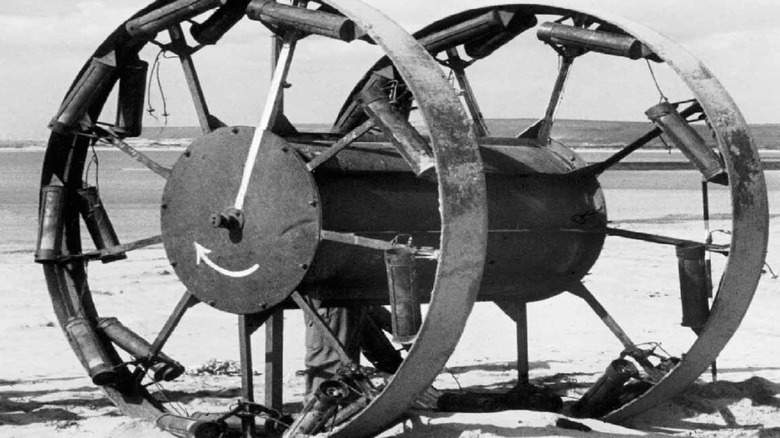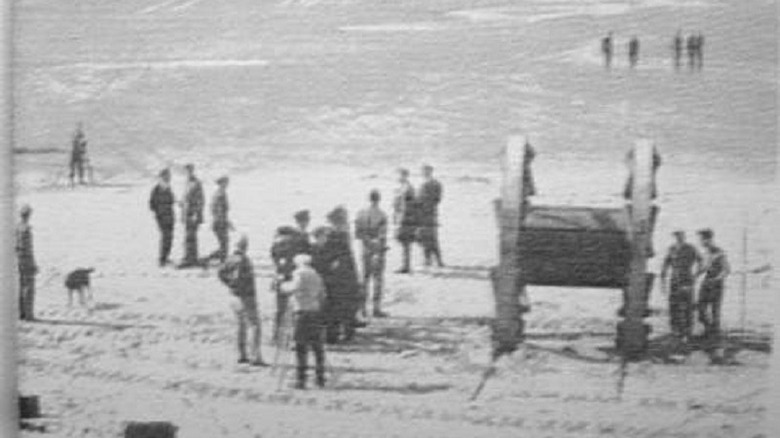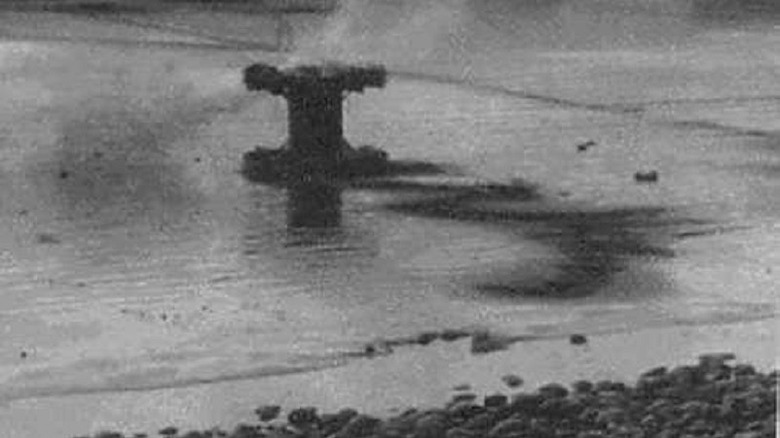The Panjandrum Went From The Allies' Super Weapon Of WWII To An Embarrassing Failure
We may receive a commission on purchases made from links.
World War II gave birth to new weapons that were invented with the goal of causing mass destruction and winning the war. Both sides — the Allied Powers and the Axis — took advantage of scientific and technological advancements to develop weapons to defeat the enemy, and while most of them were effective, there were a number of inventions that weren't so successful. Take, for instance, the Panjandrum, an odd-looking weapon that never made it past the prototype stage.
In 1942, Adolf Hitler, under Directive 40, ordered the construction of the Atlantic Wall, a coastal defense and fortification system that spanned 2,000 miles along the northern European coast. It was done in anticipation of the invasion of the Allied forces and was made up of multiple fortresses, batteries, artillery, and resistance nests. According to Military History Now, it took 17 million cubic meters of concrete and 1.2 million tons of steel to build the Atlantic Wall which had walls that stood 10 feet high and 7 feet thick. About 260,000 workers were put to the task, and the wall was completed two years later. With the defense system in place, the Allied forces needed a powerful weapon to penetrate through the concrete without having to send troops in the line of fire. The proposed solution was the Panjandrum.
How did the Panjandrum work?
The Department of Miscellaneous Weapons Development (DMWD) was a team of British experts tasked with developing weapons during World War II. The prototype Panjandrum they created was made of two wheels, each with a 10-foot diameter. The wheels were connected at the center with a hollow cylinder that was filled with explosives, so it could break through the Atlantic Wall and provide an entrance for tanks to pass through, as reported by ATI. The Panjandrum was propelled by several rockets.
The idea was for the rockets to propel the Panjandrum across the beach at a high speed and explode when it hits the Atlantic Wall. It was quick, efficient, and prevented having to send soldiers to face enemy artillery. On the day of the testing, the prototype Panjandrum, which was constructed in London, was delivered to Westward Ho!, a seaside village in Devon, England that had an identical terrain to the beaches where the Panjandrum would be used to attack the Atlantic Wall, as noted by Wired. During the test, the cylinder was filled with sand instead of explosives, which was for the best. A few problems emerged during the initial test. The power of the rockets sent the Panjandrum rolling out of control. A few changes were made to the design to make it more stable. The plan was solid, but the execution was a disaster.
The Panjandrum was a failure
The Panjandrum got a second chance after modifications were carried out. A final test was held in January 1944. Videographers, photographers, officers, and scientists were in attendance to see how the new design fared. They hoped for a better outcome than the initial tests, but again, it failed, and the result was even more disastrous than the first run, as reported by We are the Mighty. At first, the Panjandrum traveled in a straight line, but it careened off its path when the rockets came loose. The Panjandrum almost rolled over a videographer, who, fortunately, was not harmed. An officer's dog chased one of the loose rockets down the beach and was almost killed.
The incident was described in the book "Pigeon-Guided Missiles: And 49 Other Ideas That Never Took Off," which read, "The Panjandrum hurtled from the sea at wondrous speed, sparks flying from its rockets ... As rockets dislodged, the Panjandrum spun, and shock replaced the confidence of those attending. Generals fled for cover. The cameraman was almost mown down. And the Panjandrum, rockets flailing, wheels ablaze, disintegrated." After that, it was unanimously agreed that the Panjandrum was a failure, and the project was discontinued. In June 1944, the Allied forces descended upon the beaches of Normandy where the Atlantic Wall stood. Thousands of soldiers successfully breached the wall, and they did it without the help of the Panjandrum.


